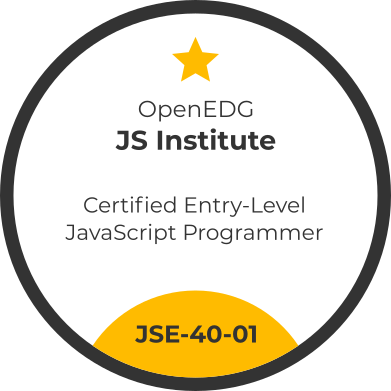- About
- Certifications
- Study Resources
-
Study Resources
- JavaScript Essentials 1
- JavaScript Essentials 2
- HTML Essentials
- CSS Essentials
General-Purpose Programming
Web Development
- Contact
- Voucher Store
Exam: JSE™ – Certified Entry-Level JavaScript Programmer
Exam Version: JSE-40-01
Status: ACTIVE
The JSE exam consists of 30 single-select and multiple-select items that assess a candidate’s grasp of JavaScript fundamentals: core syntax, variables and data types, operators, user interaction, control flow, functions (including arrow functions and simple callbacks), and basic debugging and exception handling.
Each item is worth a maximum of 10 points. After completion, the candidate’s raw score is normalized and presented as a percentage.
The exam is organized into six blocks aligned with essential entry-level JavaScript skills. Block weights indicate the relative importance of each area in the overall exam.

The table below summarizes the distribution of exam items and their respective weight in the total exam score.
Block Number
Block Name
Number of Items
Weight
1
Basics of JavaScript and Computer Programming
3
8%
2
Variables, Data Types, and Type Casting
6
20%
3
Operators and User Interaction
5
18%
4
Control Flow – Conditional Execution and Loops
6
21%
5
Functions
6
21%
6
Errors, Exceptions, Debugging, and Troubleshooting
4
12%
TOTAL
30
100%
Last updated: September 22, 2025
Aligned with Exam JSE-40-01
3 objectives covered by the block → 3 exam items
Objective 1.1.1 Understand fundamental terms and definitions
Objective 1.2.1 Set up the programming environment
Objective 1.3.1 Explain client-side execution of JavaScript code
6 objectives covered by the block → 6 exam items
Objective 2.1.1 Use variables effectively
Objective 2.2.1 Define, identify, and use primitive data types: boolean, number, bigint, undefined, null
Objective 2.3.1 Define, identify, and use the string type
length, charAt, slice, split.Objective 2.4.1 Perform type-casting operations
String, Number, BigInt, Boolean.Objective 2.5.1 Define, identify, and use complex data types: Object
Objective 2.6.1 Define, identify, and use complex data types: Array
length, indexOf, push, unshift, pop, shift, reverse, slice, concat.5 objectives covered by the block → 5 exam items
Objective 3.1.1 Recognize and use assignment, arithmetic, and string operators
Objective 3.2.1 Identify and use logical and comparison operators
Objective 3.3.1 Recognize and use the ternary and other operators
typeof, instanceof, and delete in basic scenarios.Objective 3.4.1 Understand and implement operator precedence
Objective 3.5.1 Implement simple user interaction
alert, confirm, prompt; act on user input.6 objectives covered by the block → 6 exam items
if Statements (1)Objective 4.1.1 Implement decision making with if
if and if...else; compose multiple and nested conditions.switch Statements (1)Objective 4.2.1 Implement decision making with switch
switch/case for multi-branch control.while, do...while, break, continue (1)Objective 4.3.1 Control repetition with while-family loops
break/continue safely.for Loops (1)Objective 4.4.1 Control repetition with for
for to process ranges and collections.for...in (1)Objective 4.5.1 Enumerate object keys with for...in
for...of (1)Objective 4.6.1 Traverse arrays with for...of
6 objectives covered by the block → 6 exam items
Objective 5.1.1 Organize and decompose code using functions
Objective 5.2.1 Implement interactions between a function and its environment
Objective 5.3.1 Apply function expressions and first-class patterns
Objective 5.4.1 Understand and implement recursion
Objective 5.5.1 Explain and implement callback functions
setTimeout and setInterval.Objective 5.6.1 Explain and implement arrow functions
4 objectives covered by the block → 4 exam items
Objective 6.1.1 Classify and distinguish programming errors
Objective 6.2.1 Compare and contrast JavaScript error types
SyntaxError, ReferenceError, TypeError, RangeError.Objective 6.3.1 Understand and design exception-handling mechanisms
try...catch...finally; throw custom errors with throw.Objective 6.4.1 Use basic debugging and troubleshooting techniques
Download JSE-40-01 Exam Syllabus in PDF
A Minimally Qualified Candidate (MQC) for the JSE exam is an individual with foundational knowledge of JavaScript programming. The candidate can write small scripts, work with variables and data types, use operators, gather simple user input, control program flow with conditionals and loops, decompose tasks into functions, and perform basic debugging and error handling.
The MQC understands environment setup, client-side execution, primitives and arrays/objects, type casting, operator precedence, dialog-based input, core control structures (if, switch, loops), function definitions and expressions (including arrow functions and simple callbacks), and basic exceptions and troubleshooting.
Block 1: Basics of JavaScript and Computer Programming
Minimum Coverage – the candidate can:
Block 2: Variables, Data Types, and Type Casting
Minimum Coverage – the candidate can:
Block 3: Operators and User Interaction
Minimum Coverage – the candidate can:
alert, confirm, and prompt to gather input and act on it.Block 4: Control Flow – Conditional Execution and Loops
Minimum Coverage – the candidate can:
if/switch and iterate with while, do...while, for, for...in, for...of.Block 5: Functions
Minimum Coverage – the candidate can:
Block 6: Errors, Exceptions, Debugging, and Troubleshooting
Minimum Coverage – the candidate can:
try...catch...finally, throw errors, and debug with basic tools.To pass the JSE exam, a candidate should achieve a cumulative average score of at least 70% across all exam blocks.